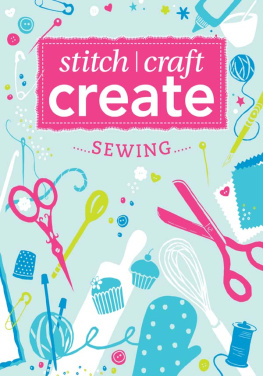Pattern Services and Revisions
If you are an Annies customer and have a question about the instructions on a pattern you have purchased, please visit:
AnniesCatalog.com/pages/customer_care/pattern_services.html
Templates
To download templates for easy printing, view the download instructions at the end of this book or click the Templates chapter in the Table of Contents.
Templates
To download templates for easy printing, go to:
AnniesCatalog.com/customers/check_code.html
and enter 1510628CF
Introduction
My mother sewed mostly from necessity, as our family was large and she needed to make every dollar count. She sewed items for the house and outfits for herself, my sister and me. They were not fancy, but I know they were most certainly sewn with love.
The first time I ever really paid attention to my mothers sewing was when I was 7 years old and a young lady from a neighboring farm asked Mom for help with a cowboy-style shirt. The fabric she was using was the prettiest shade of turquoise I had ever seen.
While the color of the shirt was certainly what drew me in, I was fascinated by the fact that someone was asking Mom for help with sewing. Didnt everyones mother know how to sew?
As I grew older, Mom showed me the basics of her sewing machine, and I made a few dresses and shirts for myself as well as some doll clothes. In the process, I found my passion.
This book is for anyone and everyone who wants to learn the basics of sewing while creating fun projects through the combination of interesting fabric print and color combinations.
Each project in this book is designed to introduce a new technique while utilizing newly mastered skills from the previous project.
I hope you enjoy this book and make good use of your new skills, planning sewing projects and making them pretty with confidence.
Lorine
Meet the Designer

A passion for sewing and an eye for detail are the cornerstones of Lorine Masons professional life.
An accomplished project designer, she is also the author of 12 crafting and sewing books, as well as the designer behind three pattern lines which are published under the name Lorine Mason Designs. She is also a licensed product designer.
Lorine currently writes the Sewing Savvy newsletter found at AnniesCatalog.com/Sewing_Savvy.php, as well as a personal blog available at www.lorinemason.com/blog.
She lives in Virginia with her husband, Bill.
Table of Contents
Interested in learning how to sew? Lucky you! You have come to exactly the right place to get started. After reviewing the basics and getting to know your machine, you will be ready to make a kitchen full of snappy accessories.
Getting to Know Your Sewing Machine
Whether you have a machine with manual controls or a top-of-the-line computerized machine, begin by reading through your sewing machine manual to become familiar with the basics of using your personal machine.
Familiarize yourself with your machines basic parts and all the attachments that are included with your machine. Learn how to connect your machine to a power supply and the foot control.
Explore any built-in extras your machine may have, such as: a needle-down function that allows you to stop your machine with the needle in the down position each time, or an automatic thread cutter and backstitch at the end of a seam.
Discover how to adjust stitch length and change needle position, and how to adjust and change presser feet on your machine.
Learn and practice loading bobbins, inserting the bobbins into the machine, and threading your machine and needle.
Explore all attachments that came with your machine. Your manual will give you instructions on how to add individual attachments to your machine and how to use those attachments.
Practice Tip
Using an old sewing machine needle, practice straight stitching on lined paper without thread before stitching on layers of fabric. Also, draw circles, curves, and inside and outside corners on paper to practice.
Paper dulls needles, so change your needle before attempting to sew on fabric.
Practice, Practice, Practice
Start your sewing experience by practicing the following: stitching straight stitch seams, pivoting to turn corners, stitching around curves and stitching samples of the stitches you have available on your machine.
Straight Stitching
Thread your machine with a different color of thread in the bobbin and in the needle.
Set your machine to stitch a medium-length straight stitch (about 10 stitches per inch).
Align the edges of two layers of fabric right sides together and place them under the presser foot of your sewing machine.
Position the fabric edges at the -inch seam width marking on your sewing machines stitch guide plate.
Stitch 3 or 4 stitches. Use your reverse-stitch button to backstitch over the original stitches to lock the beginning of the seam.
Continue stitching and carefully guide the fabric under the presser foot with the edge at the correct seam width marking. Do not pull or push the fabric under the needle. Your machine does it for you at an even speed.
Stitching Tip
Do not pull or push fabric through your sewing machine!Pushing or pulling fabric will stretch the fabric and cause uneven stitches. You could also break needles and/or thread. Let the machine feed dogs do the work. Just carefully guide your fabric under the presser foot.
Stitch slowly to begin with, learning to control your fabric and machine, and then increase your speed. When you have completed a row of stitching, backstitch to secure the end of the seam. Trim the thread ends.
Check your seam allowance. Is it a consistent inch wide? Practice until you are confident you can stitch the same width for the entire length of a seam. Try different widths: , and inch wide.
Stitching Tip
Position a strip of blue painters tape along your stitch guide plate and over the machine bed to extend the stitching guidelines. You can also purchase a larger stitch guide to place over your machines stitch guide plate.
Pivoting
To practice pivoting on corners:
Use a ruler and fabric marker to draw right angles on wrong side of fabric (Figure 1).

Stitch on a line to the point of the corner using a straight stitch. Stop stitching at the corner with the needle down in the fabric.
Raise the presser foot and turn the fabric 90 degrees in the direction of the adjoining line. Lower the presser foot and continue stitching on the marked line.
Lower the presser foot and continue stitching.
To practice pivoting around outside edges:
Cut several 5-inch practice squares. Begin stitching along the side of one square with the fabric edge on the -inch-wide stitch guide.
Stitch to within inch of the next side at the first corner. Raise the presser foot and turn the fabric, positioning the next side along the -inch-wide stitch guide, and continue stitching.
Repeat for all four corners and sides. Continue practicing with 5-inch squares until you are comfortable with pivoting and can keep a consistent seam width.
Marking Tip
Mark the pivoting points on the wrong side of the fabric to make sure you pivot equidistantly from each side of the corner.







